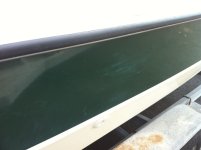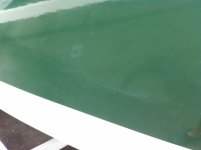I've searched various threads and have an idea what I want to do but need some confirmation. After three boating seasons and numerous run-ins with docks and pilings etc, we've produced some unsightly scratches on the gelcoat, most notably on the green trim. These scratches are not gouges but have defintely scratched the gelcoat surface. The worst of which occurred after rubbing against a piling, which produced several scratches about a foot-long, like scraping a big sharp comb against the hull and leaving about eight uniform scratches across the surface. :cry
My question: Would rubbing compound get these surface scratches out? Or would I have to use wet/dry sandpaper and sand the affected areas first? I'm hoping that I could just use rubbing compound, buff it out, then wax the entire hull to make it look like new. What's the verdict?
Peter
C-Dancer
My question: Would rubbing compound get these surface scratches out? Or would I have to use wet/dry sandpaper and sand the affected areas first? I'm hoping that I could just use rubbing compound, buff it out, then wax the entire hull to make it look like new. What's the verdict?
Peter
C-Dancer


